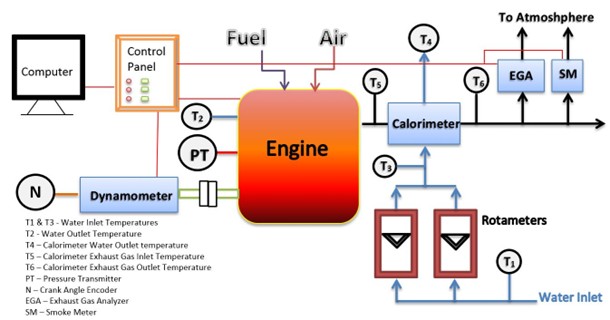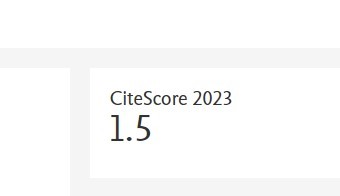Optimización de parámetros de inyección para mezclas eficientes de biodiésel en motores de encendido por compresión
Resumen
La creciente demanda mundial de energía, el agotamiento de las reservas de petróleo, la volatilidad de los precios del crudo y las crecientes preocupaciones ambientales han acelerado la búsqueda de fuentes de energía sostenibles y limpias. El biodiésel (éster metílico) se produjo a partir de aceite de escoria (MESO) y aceite vegetal usado (MEWVO) mediante transesterificación, utilizando hidróxido de sodio y metanol como catalizador y reactivo. La composición de los ésteres metílicos en MESO y MEWVO fue analizada mediante Cromatografía de Gases-Espectrometría de Masas (GC-MS). Se prepararon diversas mezclas de ésteres metílicos con diésel puro, seleccionándose la mejor mezcla para su uso en motores de encendido por compresión (CI).
Se estudiaron las características de desempeño, emisiones y combustión de las mezclas MESO-B20 y MEWVO-B20. Los resultados mostraron que el retraso del tiempo de inyección (19° antes del PMS) redujo significativamente el retardo de ignición en un 15% y mejoró la eficiencia térmica al freno (BTE) en un 6.4% en comparación con el tiempo de inyección estándar. El aumento de la presión de inyección a 220 bar mejoró la atomización del combustible, lo que condujo a una reducción del 10% en el consumo específico de combustible al freno (BSFC) y a una disminución del 5% en la temperatura de los gases de escape (EGT).
Estos hallazgos demuestran que MESO-B20 y MEWVO-B20, con parámetros de inyección optimizados, son una alternativa viable al diésel convencional en motores CI, mostrando mejoras en la eficiencia de combustión y reducciones de emisiones, particularmente en CO e hidrocarburos no quemados (HC), aunque se observó un incremento en las emisiones de NOx. Se recomienda continuar la investigación para abordar las emisiones de NOx y optimizar las formulaciones de biodiésel para el rendimiento a largo plazo del motor.
Referencias bibliográficas
Wamankar, A. K., & Murugan, S. (2015). Effect of injection timing on a DI diesel engine fuelled with a synthetic fuel blend. Journal of the Energy Institute, 88(4), 406–413. https://doi.org/10.1016/j.joei.2014.11.003Monyem, A., Van Gerpen, H. J. (2001). The effect of biodiesel oxidation on engine performance and emissions. Biomass and Bioenergy, 20(4), 317–325. https://doi.org/10.1016/S0961-9534(00)00095-7.
Ahmed, S. A., Zhou, S., Zhu, Y., Feng, Y., Malik, A., & Ahmad, N. (2019). Influence of injection timing on performance and exhaust emission of CI engine fuelled with butanol–diesel using a 1D GT-Power model. Processes, 7(5), 299. https://doi.org/10.3390/pr7050299
Atmanlı, A., İleri, E., & Yüksel, B. (2014). Experimental investigation of engine performance and exhaust emissions of a diesel engine fueled with diesel–n-butanol–vegetable oil blends. Energy Conversion and Management, 81, 312–321. https://doi.org/10.1016/j.enconman.2014.02.049
Baek, H.-M., Jung, G.-S., Vuong, Q. D., Lee, J.-U., & Lee, J.-W. (2023). Effect of performance by excessive advanced fuel injection timing on marine diesel engine. Applied Sciences, 13(16), 9263. https://doi.org/10.3390/app13169263
Jayashankara, B., & Ganesan, V. (2010). Effect of fuel injection timing and intake pressure on the performance of a DI diesel engine – A parametric study using CFD. Energy Conversion and Management, 51(10), 1835–1848. https://doi.org/10.1016/j.enconman.2009.11.006.
Bakar, R. A., Semin, & Ismail, A. R. (2008). Fuel injection pressure effect on performance of direct injection diesel engines based on experiment. American Journal of Applied Sciences, 5(3), 197–202. https://doi.org/10.3844/ajassp.2008.197.202
Kathirvelu, B., Subramanian, S., Govindan, N., & Santhanam, S. (2017). Emission characteristics of biodiesel obtained from jatropha seeds and fish wastes in a diesel engine. Sustainable Environment Research, 27(6), 283–290. https://doi.org/10.1016/j.serj.2017.06.004.
Komintarachat, C., & Chuepeng, S. (2010). Methanol-based transesterification optimization of waste used cooking oil over potassium hydroxide catalyst. American Journal of Applied Sciences, 7(8), 1073–1078. https://doi.org/10.3844/ajassp.2010.1073.1078.
Sun, C., Kang, D., Bohac, S. V., & Boehman, A. L. (2016). Impact of fuel and injection timing on partially premixed charge compression ignition combustion. Energy & Fuels, 30(5), 4331–4345. https://doi.org/10.1021/acs.energyfuels.6b00257El-Hamidi, M., & Zaher, F. A. (2018). Production of vegetable oils in the world and in Egypt: An overview. Bulletin of the National Research Centre, 42(1), 19. https://doi.org/10.1186/s42269-018-0019-0.
Öztürk, E., Can, Ö., Usta, N., & Yücesu, H. S. (2020). Effects of retarded fuel injection timing on combustion and emissions of a diesel engine fueled with canola biodiesel. Engineering Science and Technology, an International Journal, 23(6), 1466–1475. https://doi.org/10.1016/j.jestch.2020.06.008.
Salvador, F. J., Martínez-López, J., Romero, J.-V., & Roselló, M.-D. (2011). Influence of biofuels on the internal flow in diesel injector nozzles. Mathematical and Computer Modelling, 54(7–8), 1699–1705. https://doi.org/10.1016/j.mcm.2010.12.010.
Folayan, A. J., Anawe, P. A. L., Aladejare, A. E., & Ayeni, A. O. (2019). Experimental investigation of the effect of fatty acids configuration, chain length, branching and degree of unsaturation on biodiesel fuel–diesel properties obtained from lauric oils, high-oleic and high-linoleic vegetable oil biomass. Energy Reports, 5, 793–806. https://doi.org/10.1016/j.egyr.2019.06.013
Kannan, G. R., & Anand, R. (2012). Effect of injection pressure and injection timing on DI diesel engine fuelled with biodiesel from waste cooking oil. Biomass and Bioenergy, 46, 343–352. https://doi.org/10.1016/j.biombioe.2012.08.006.
Suresh, G., Kamath, H. C., & Banapurmath, N. R. (2013). Effects of injection timing, injector opening pressure and nozzle geometry on the performance of cottonseed oil methyl ester-fuelled diesel engine. International Journal of Sustainable Engineering, 7(1), 82–92. https://doi.org/10.1080/19397038.2013.811703.
Rao, G., Kumar, G. N., & Herbert, M. (2018). Effect of injection pressure on the performance and emission characteristics of the CI engine using Vateria indica biodiesel. International Journal of Ambient Energy, 40(7), 758–767. https://doi.org/10.1080/01430750.2017.1421575
Labeckas, G., & Slavinskas, S. (2005). Performance and exhaust emissions of direct‐injection diesel engine operating on rapeseed oil and its blends with diesel fuel. Transport, 20(5), 186–194. https://doi.org/10.3846/16484142.2005.9638019.
Harish, H., Shashi Kumar, C. R., Rajanna, S., & Prakash, G. S. (2014). Experimental investigation on the performance and emission characteristics of edible & non-edible oil. International Journal of Emerging Technology and Advanced Engineering, 4(10), 648–655.
Kalargaris, Ioannis, Tian, Guohong, Gu, Sai, Influence of Advanced Injection Timing and Fuel Additive on Combustion, Performance, and Emission Characteristics of a DI Diesel Engine Running on Plastic Pyrolysis Oil, Journal of Combustion, 2017, 3126342, 9 pages, 2017. https://doi.org/10.1155/2017/3126342
Çelıkten, İ. (2003). An experimental investigation of the effect of the injection pressure on engine performance and exhaust emission in indirect injection diesel engines. Applied Thermal Engineering, 23(16), 2051–2060. https://doi.org/10.1016/S1359-4311(03)00171-6
Pullen, J., & Saeed, K. (2012). An overview of biodiesel oxidation stability. Renewable and Sustainable Energy Reviews, 16(8), 5924–5950. https://doi.org/10.1016/j.rser.2012.06.024.
Jayaraman, J., Alagu, K., Venu, H., Appavu, P., Joy, N., Jayaram, P., & Mariadhas, A. (2019). Enzymatic production of rice bran biodiesel and testing of its diesel blends in a four-stroke CI engine. Energy Sources, Part A: Recovery, Utilization, and Environmental Effects, 45(2), 5340–5351. https://doi.org/10.1080/15567036.2019.1671554
Tyson, K. S. (2004). Biodiesel handling and use guidelines (Report No. DOE/GO-102004-1999). U.S. Department of Energy, Energy Efficiency and Renewable Energy.
Abed, K. A., El Morsi, A. K., Sayed, M. M., El Shaib, A. A., & Gad, M. S. (2018). Effect of waste cooking-oil biodiesel on performance and exhaust emissions of a diesel engine. Egyptian Journal of Petroleum, 27(4), 985–989. https://doi.org/10.1016/j.ejpe.2018.02.008.
Kaisan, M. U., Anafi, F. O., Nuszkwoski, J., Kulla, D. M., & Umaru, S. (2016). GC/MS analysis of methyl esters of biodiesel produced from cotton seed oil. Nigerian Journal of Solar Energy, 27.
Kantharaju, T., Harish, H., Subbaramaiah, S. V., Rajanna, S., & Prakash, G. (2015). Performance and emission characterization of waste chicken fat biodiesel as an alternate fuel. International Journal of Emerging Technology and Advanced Engineering, 5(5), 191–200.
Karthikeyan, A., Alagu, K., & Rajasekar, R. (2014). Effect of compression ratio, injection timing and injection pressure on the performance of diesel engine fuelled with B20 blend of jatropha methyl ester. International Journal of Applied Engineering Research, 9, 17167–17180.
Kavitha, V., Geetha, V., & Jacqueline, P. J. (2019). Production of biodiesel from dairy waste scum using eggshell waste. Process Safety and Environmental Protection, 125, 279–287. https://doi.org/10.1016/j.psep.2019.03.021.
Kelessidis, A., & Stasinakis, A. S. (2012). Comparative study of the methods used for treatment and final disposal of sewage sludge in European countries. Waste Management, 32(7), 1186–1195. https://doi.org/10.1016/j.wasman.2012.01.012.
Khujamberdiev, R., & Cho, H. (2023). Impact of biodiesel blending on emission characteristics of one-cylinder engine using waste swine oil. Energies, 16(14), 5489. https://doi.org/10.3390/en16145489
Kim, H. Y., Ge, J. C., & Choi, N. J. (2019). Effects of fuel injection pressure on combustion and emission characteristics under low speed conditions in a diesel engine fueled with palm oil biodiesel. Energies, 12(17), 3264. https://doi.org/10.3390/en12173264
Krishnamurthy, K. N., & Sridhara, S. N. (2018). Experimental investigation of the effect of injection pressure on performance and emission of DI diesel engine fueled with scum oil methyl ester blends. International Journal of Engineering & Technology, 7(2.32), 525–536. https://doi.org/10.23880/PPEJ-16000143.
Kulandaivel, D., Rahamathullah, I. G., Sathiyagnanam, A. P., Gopal, K., Damodharan, D., & Melvin Victor, D. P. (2020). Effect of retarded injection timing and EGR on performance, combustion and emission characteristics of a CRDi diesel engine fueled with WHDPE oil/diesel blends. Fuel, 278, 118304. https://doi.org/10.1016/j.fuel.2020.118304.
de Menezes, L. C., de Sousa, E. R., da Silva, G. S., Brandes Marques, A. L., Costa Viegas, H. D., & Castro dos Santos, M. J. (2022). Investigations on storage and oxidative stability of biodiesel from different feedstocks using the Rancimat method, infrared spectroscopy, and chemometry. ACS Omega, 7(35), 30746–30755. https://doi.org/10.1021/acsomega.2c01348.
Asokan, M. A., Senthur Prabu, S., Kamesh, S., & Khan, W. (2018). Performance, combustion and emission characteristics of diesel engine fuelled with papaya and watermelon seed oil biodiesel/diesel blends. Energy, 145, 238–245. https://doi.org/10.1016/j.energy.2017.12.140.
Harun Kumar, M., Dhana Raju, V., Kishore, P. S., & Venu, H. (2018). Influence of injection timing on the performance, combustion and emission characteristics of diesel engine powered with tamarind seed biodiesel blend. International Journal of Ambient Energy, 41(9), 1007–1015. https://doi.org/10.1080/01430750.2018.1501741.
Kumar, M. V., Babu, A. V., & Kumar, P. R. (2018). The impacts on combustion, performance and emissions of biodiesel by using additives in direct injection diesel engine. Alexandria Engineering Journal, 57(1), 509–516. https://doi.org/10.1016/j.aej.2016.12.016.
Dorado, M. P., Ballesteros, E., Lopez, F. J., & Mittelbach, M. (2004). Optimization of alkali-catalyzed transesterification of Brassica carinata oil for biodiesel production. Energy & Fuels, 18(1), 77–83. https://doi.org/10.1021/ef0340110.
Gad, M. S., El-Araby, R., & Abed, K. A. (2018). Performance and emissions characteristics of C.I. engine fueled with palm oil/palm oil methyl ester blended with diesel fuel. Egyptian Journal of Petroleum, 27(2), 215–219. https://doi.org/10.1016/j.ejpe.2017.05.009.
Mani, M., Nagarajan, G., & Sampath, S. (2011). Characterization and effect of using waste plastic oil and diesel fuel blends in compression ignition engine. Energy, 36(1), 212–219. https://doi.org/10.1016/j.energy.2010.10.049
Elahi, M., Soudagar, M., & Shelare, S. (2024). Optimizing IC engine efficiency: A comprehensive review on biodiesel, nanofluid, and the role of artificial intelligence and machine learning. Energy Conversion and Management, 307, 118337. https://doi.org/10.1016/j.enconman.2024.118337
Semakula, M., & Inambao, F. (2018). The formation, effects and control of oxides of nitrogen in diesel engines. International Journal of Applied Engineering Research, 13(6), 3200–3209.
Mondal, P. K., & Mandal, B. K. (2024). Effect of fuel injection pressure on the performances of a CI engine using water-emulsified diesel (WED) as a fuel. Energy, Sustainability and Society, 14, 12. https://doi.org/10.1186/s13705-024-00442-7
Mutyalu, K. B., Das, V. C., & Srinivasa Rao, K. (2018). Effect of fuel injection pressure on performance and emission characteristics of DI-CI engine with shea olein biodiesel. Materials Today: Proceedings, 5(1), 494–500. https://doi.org/10.1016/j.matpr.2017.11.110
Banapurmath, N. R., Tewari, P. G., & Hosmath, R. S. (2008). Effect of biodiesel derived from Honge oil and its blends with diesel when directly injected at different injection pressures and injection timings in single-cylinder water-cooled compression ignition engine. Proceedings of the IMechE, Part A: Journal of Power and Energy, 223(6), 737–746. https://doi.org/10.1243/09576509JPE673.
Banapurmath, N. R., Tewari, P. G., & Hosmath, R. S. (2008). Combustion and emission characteristics of a direct injection, compression‐ignition engine when operated on Honge oil, HOME and blends of HOME and diesel. International Journal of Sustainable Engineering, 1(2), 80–93. https://doi.org/10.1080/19397030802221265
Naik, N. S., & Balakrishna, B. (2017). A comparative study of performance and combustion characteristics of a CI diesel engine fuelled with B20 biodiesel blends. International Journal of Ambient Energy, 40(1), 21–27. https://doi.org/10.1080/01430750.2017.1360199
Özdalyan, B., & Özer, S. (2011). The effects of using 2-butanol-diesel fuel mixture on a compression ignition engine at different injector spraying pressures. Technology, 14(1), 23–31. Retrieved from http://jestech.karabuk.edu.tr/arsiv/index.asp.
Vara Prasad, P., Durga Prasad, B., & Hari Prakash, R. (2013). Effect of injection timing on performance and emission characteristics of 4S-single cylinder DI diesel engine using PME blend as fuel. International Journal of Engineering Research & Technology, 2(12), 3201–3207.
Patel, A., Arora, N., Mehtani, J., Pruthi, V., & Pruthi, P. A. (2017). Assessment of fuel properties on the basis of fatty acid profiles of oleaginous yeast for potential biodiesel production. Renewable and Sustainable Energy Reviews, 77, 604–616. https://doi.org/10.1016/j.rser.2017.04.016
Appavu, P., Ramanan M, V., Jayaraman, J., & Venu, H. (2019). NOx emission reduction techniques in biodiesel-fuelled CI engine: a review. Australian Journal of Mechanical Engineering, 19(2), 210–220. https://doi.org/10.1080/14484846.2019.1596527
Punith Kumar, S. V., & Harish, H. (2015). Experimental investigation on injection parameters by varying CR using fish oil biodiesel in diesel engine. International Journal for Ignited Minds, 2(1), 12–40.
Kumar, R., Dixit, A. K., & Sharma, R. K. (2015). Properties and use of Jatropha curcas ethyl ester and diesel fuel blends in variable compression ignition engine. Journal of Scientific and Industrial Research, 74(6), 343–347.
Sathiyamoorthi, R., & Sankaranarayanan, G. (2015). Fuel injection timings of a direct injection diesel engine running on neat lemongrass oil-diesel blends. International Journal of Automotive and Mechanical Engineering, 11, 2348–2363. https://doi.org/10.15282/ijame.11.2015.16.0197.
Sindhu, R., Rao, G. A. P., & Murthy, K. M. (2018). Effective reduction of NOx emissions from diesel engine using split injections. Alexandria Engineering Journal, 57(3), 1379–1392. https://doi.org/10.1016/j.aej.2017.06.009.
R., B., Sircar, A., P., S., & V., A. (2018). Conversion of bio-solids (scum) from tannery effluent treatment plant into biodiesel. Energy Sources, Part A: Recovery, Utilization, and Environmental Effects, 40(8), 959–967. https://doi.org/10.1080/15567036.2018.1468507.
Rahees, K., & Meera, V. (2014). Production of biodiesel from dairy waste scum. International Journal of Scientific & Engineering Research, 5(7), 194–199..
Raheman, H., & Padhee, D. (2014). Combustion characteristics of diesel engine using producer gas and blends of Jatropha methyl ester with diesel in mixed fuel mode. International Journal of Renewable Energy Development, 3(3), 228–235. https://doi.org/10.14710/ijred.3.3.228-235.
Roy, M. M. (2009). Effect of fuel injection timing and injection pressure on combustion and odorous emissions in DI diesel engines. Journal of Energy Resources Technology, 131(3), 032201. https://doi.org/10.1115/1.3185346
Saravanan, S., Nagarajan, G., Lakshmi Narayana Rao, G., & Sampath, S. (2014). Theoretical and experimental investigation on effect of injection timing on NOx emission of biodiesel blend. Energy, 66, 216–221. https://doi.org/10.1016/j.energy.2014.01.003
Gowthaman, S., & Sathiyagnanam, A. P. (2016). Effects of charge temperature and fuel injection pressure on HCCI engine. Alexandria Engineering Journal, 55(1), 119–125. https://doi.org/10.1016/j.aej.2015.12.025.
Jindal, S. (2011). Effect of injection timing on combustion and performance of a direct injection diesel engine running on Jatropha methyl ester. International Journal of Energy and Environment, 2(1), 113–122..
Yadav, S. P. R., Saravanan, C. G., & Kannan, M. (2015). Influence of injection timing on DI diesel engine characteristics fueled with waste transformer oil. Alexandria Engineering Journal, 54, 881–888. https://doi.org/10.1016/j.aej.2015.07.008.
Rostami, S., Ghobadian, B., & Kiani Deh Kiani, M. (2014). Effect of the injection timing on the performance of a diesel engine using diesel-biodiesel blends. International Journal of Automotive and Mechanical Engineering, 10, 1945–1958. https://doi.org/10.15282/ijame.10.2014.12.0163
Saravanan, S., Nagarajan, G., Lakshmi Narayana Rao, G., & Sampath, S. (2014). Theoretical and experimental investigation on effect of injection timing on NOx emission of biodiesel blend. Energy, 66, 216–221. https://doi.org/10.1016/j.energy.2014.01.003
Salmani, M. H., Rehman, S., Zaidi, K., & Hasan, A. K. (2015). Study of ignition characteristics of microemulsion of coconut oil under off diesel engine conditions. Engineering Science and Technology, an International Journal, 18(3), 318–324. https://doi.org/10.1016/j.jestch.2014.12.002
Patil, S., & Akarte, M. M. (2012). Effect of injection pressure on CI engine performance fuelled with biodiesel and its blends. International Journal of Scientific & Engineering Research, 3(3).
Sarno, M., & Iuliano, M. (2020). Biodiesel production from dairy waste scum by using an efficient nano-biocatalyst. Chemical Engineering Transactions, 79, 181–186. https://doi.org/10.3303/CET207903.
Sathish Kumar, P. S., & Mahalingam, S. (2014). Effect of injection timing on performance and emission analysis of single cylinder diesel engine fuelled with dual bio-fuels. International Journal of Advanced Mechanical Engineering, 4(5), 487–496.
Shivashimpi, M., Banapurmath, N. R., Alur, S. A., & Khandal, S. V. (2019). Effect of injection parameters: Injection timing and injection pressure on the performance of diesel engine fueled with palm oil methyl ester. European Journal of Sustainable Development Research, 3(2), em0077. https://doi.org/10.20897/ejosdr/3918
Shrivastava, P., & Verma, T. N. (2020). Effect of fuel injection pressure on the characteristics of CI engine fuelled with biodiesel from Roselle oil. Fuel, 265, 117005. https://doi.org/10.1016/j.fuel.2019.117005
Shundoh, S., Komori, M., Tsujimura, K., & Kobayashi, S. (1992). NOx reduction from diesel combustion using pilot injection with high pressure fuel injection. SAE Technical Paper 920461. https://doi.org/10.4271/920461
Singh, S., Krishnan, S. R., Srinivasan, K. K., Midkiff, K. C., & Bell, S. R. (2004). Effect of pilot injection timing, pilot quantity and intake charge conditions on performance and emissions for an advanced low-pilot-ignited natural gas engine. International Journal of Engine Research, 5(4), 329–348. https://doi.org/10.1243/146808704323224231.
Yellapu, S. K., Kaur, R., & Tyagi, R. D. (2019). Oil extraction from scum and ex situ transesterification to biodiesel. Biofuels, 12(6), 715–722. https://doi.org/10.1080/17597269.2018.1532753.
Srivastava, A. K., Soni, S. L., Sharma, D., & Jain, N. L. (2018). Effect of injection pressure on performance, emission, and combustion characteristics of diesel–acetylene-fuelled single cylinder stationary CI engine. Environmental Science and Pollution Research, 25(8), 7767–7775. https://doi.org/10.1007/s11356-017-1070-3.
Suthisripok, T., & Semsamran, P. (2018). The impact of biodiesel B100 on a small agricultural diesel engine. Tribology International, 128, 397–409. https://doi.org/10.1016/j.triboint.2018.07.042.
Priyanka, T. A., & Gawande, A. P. (2013). Production of biodiesel & glycerine by using dairy waste. International Journal for Engineering Applications and Technology, 1.
Tamilselvan, P., Sassykova, L., Prabhahar, M., Kathirvelu, B., Kannayiram, G., Subramanian, S., & Prakash, S. (2020). Influence of saturated fatty acid material composition in biodiesel on its performance in internal combustion engines. Materials Today: Proceedings, 33, 1181–1186. https://doi.org/10.1016/j.matpr.2020.07.626.
Abdallah, T. (2017). Sustainable mass transit. In Chapter 1 (pp. 1–14). Elsevier. https://doi.org/10.1016/B978-0-12-811299-1.00001-0.
Dhana Raju, V., Kishore, P. S., Nanthagopal, K., & Ashok, B. (2018). An experimental study on the effect of nanoparticles with novel tamarind seed methyl ester for diesel engine applications. Energy Conversion and Management, 164, 655–666. https://doi.org/10.1016/j.enconman.2018.03.032.
Sabu, V. R., Thomas, J. J., & Nagarajan, G. (2020). Experimental investigation on the effects of multiple injections and EGR on pentanol biodiesel-fuelled RCCI engine. RSC Advances, 10(49), 29498–29509. https://doi.org/10.1039/d0ra03723k
Belagur, V. K., & Chitimini, V. R. (2012). Influence of static injection timing on combustion, emission and performance characteristics of DI diesel engine fuelled with honne oil methyl ester. International Journal of Ambient Energy, 33, 65–74. https://doi.org/10.1080/01430750.2011.636209.
Vijay Kumar, M., Veeresh Babu, A., & Ravi Kumar, P. (2018). The impacts on combustion, performance and emissions of biodiesel by using additives in direct injection diesel engine. Alexandria Engineering Journal, 57(1), 509–516. https://doi.org/10.1016/j.aej.2016.12.016
Yatish, K. V., Lalithamba, H. S., Suresh, R., Arun, S. B., & Kumar, P. V. (2016). Optimization of scum oil biodiesel production by using response surface methodology. Process Safety and Environmental Protection, 102, 667–672. https://doi.org/10.1016/j.psep.2016.05.026
Yesilyurt, M. K., Yilbasi, Z., & Aydin, M. (2020). The performance, emissions, and combustion characteristics of an unmodified diesel engine running on the ternary blends of pentanol/safflower oil biodiesel/diesel fuel. Journal of Thermal Analysis and Calorimetry, 140, 2903–2942. https://doi.org/10.1007/s10973-020-09376-6
Zhang, Y., Lou, D., Tan, P., Hu, Z., & Fang, L. (2022). Effects of waste-cooking-oil biodiesel blends on diesel vehicle emissions and their reducing characteristics with exhaust after-treatment system. Journal of Cleaner Production, 381(Part 1), 135190. https://doi.org/10.1016/j.jclepro.2022.135190
Zhang, Y., Zhong, Y., Wang, J., Tan, D., Zhang, Z., & Yang, D. (2021). Effects of different biodiesel-diesel blend fuel on combustion and emission characteristics of a diesel engine. Processes, 9(11), 1984. https://doi.org/10.3390/pr9111984
Zhou, H., Zhao, H.-W., Huang, Y.-P., Wei, J.-H., & Peng, Y.-H. (2019). Effects of injection timing on combustion and emission performance of dual-fuel diesel engine under low to medium load conditions. Energies, 12(12), 2349. https://doi.org/10.3390/en12122349
Descargas

Derechos de autor 2025 CT&F - Ciencia, Tecnología y Futuro

Esta obra está bajo una licencia internacional Creative Commons Atribución-NoComercial-CompartirIgual 4.0.

| Estadísticas de artículo | |
|---|---|
| Vistas de resúmenes | |
| Vistas de PDF | |
| Descargas de PDF | |
| Vistas de HTML | |
| Otras vistas | |










